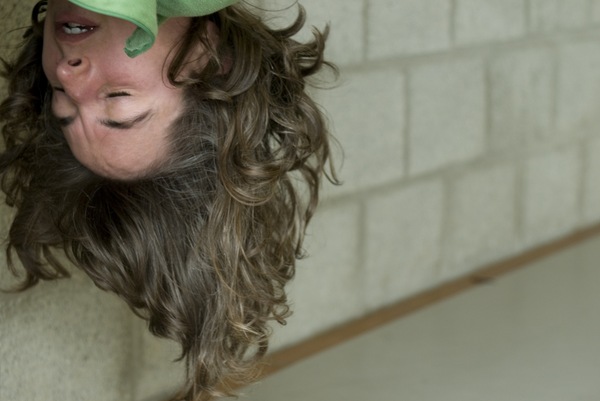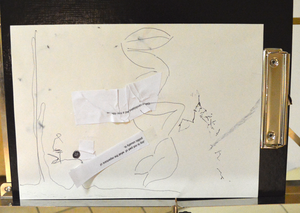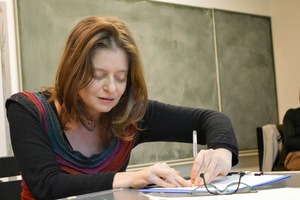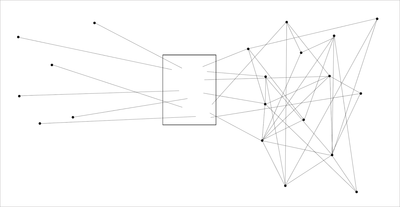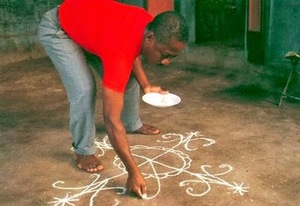performer: Sonia Si Ahmed, photo © Aurore Dal Mas
introduction
Can ‘enchanting scores’ create the conditions for alternative forms of relationality and agency to emerge? Exploring the critical potential of trance practices in today’s art and society was at the heart of Enchanting Scores, a four-days event organized by Sarma in collaboration with choreographer and visual artist Julien Bruneau. In a salon at the Kaaistudio’s in Brussels on November 18, 2013, philosopher Isabelle Stengers, anthropologist Arnaud Halloy and Julien Bruneau set up a conversation on trance and relational practices between magic, science and the arts. Afterwards the audience was invited to work with these ideas and perspectives in a scored collective thinking process. In a workshop for professional artists at Bains Connective in Brussels (November 19-21, 2013), Julien Bruneau and Arnaud Halloy worked towards collective drawings and a shared mythology, based on scores that provide a set of constraints triggering a dynamic interplay between interiority and collectivity. Addressing practices of trance and other non-ordinary states, the workshop explored diverse modes of relationality and opens up the question of human agency. How do we relate to an overwhelming stream of corporeal sensations, thoughts, emotions and imagination?
Practice gives you an insight in the process at the core of the workshop.
Salon proposes an excerpt of the scored talk between Isabelle Stengers, Arnaud Halloy and Julien Bruneau during the salon.
Technologies of enchantment introduces an anthropological perspective on the question of trance.
lure practice
practice
The workshop was based on a consistent process developed throughout the three days. It started with the creation of collective drawings. The analysis of one of them, by the group that made it, gave rise to a complex web of notions, themes and images associated with one another. This common “landscape” was then further explored individually through a chain of transformation involving drawing, speech and dance. We looked at how the shared mythology developed from the original drawing could be manifested within one’s own sensations, imagination, thinking and emotions. How could one turn into a vessel for a hybrid entity, at once individual and collective; material and immaterial (made out of paper, ink, objects, bodies but also images, concepts and feelings)?
. . . . . . . . . . . . . . . . . .
1- collective drawings :
. . . . . . . . . . . . . . . . . .
The initial practice conveys an array of heterogeneous actions towards the making of collective drawings. In order to generate gestural traces on the paper, each participant works alternately
from tactile exploration of the environment and textures of movement while dancing. They also compose with language, using a pile of printed quotes they cut and paste or copy. The resulting drawings emerge from a logic of accumulation, or collage, each being at the intersection of the different people’s trajectory. The outcome is the images themselves as much as the experience of the participants who interwove distinct modes of relation (the sensorial, the kinesthetic, the reflexive and the pictorial) into unsettled intensity.
. . . . . . . . . .
2- exegesis :
. . . . . . . . . .
One of the drawings is selected by the group. By observing it and talking about it, they try to let its ‘own’ voice be heard. They map out onto a large sheet the interconnected notions sprouting from their reading of the drawing. It is not so much an interpretation – which would put the emphasis on the subjectivity and relativity of the analysis – as it is an exegesis of it: a thorough and rigorous
reading aiming at accuracy, as one would do in front of some undeciphered manuscript from the past. Yet, the drawing opens up to rather delirious associations thanks to its heterogeneous, open-ended composition. Daring leaps are offered between the expressive formlessness of some traces, the imagery triggered by yet other ones and the various tones of the verbal statements (philosophical, political or fictional). The dynamic tension between rigor and delirium defines the efficacy of this practice as well as of the following steps of the process.
. . . . . . . .
3- altar :
. . . . . . . .
On the second day, everyone brings an image and an object as a means to further process the landscape developed with the exegesis. After the materiality of the drawing and the immateriality of the exegesis we are back to materiality with objects and printed images. These artifacts are placed on a table next to the drawing and its ‘map’ (the large paper sheet bearing the keywords from the
exegesis). On the same table we place a bunch of flowers, a glass of water and a lit candle as a way to nourish the liveliness of the landscape that will go on animating us in the next days.
. . . . . . . . . . . . . . . . . . . . . . . . .
4- individual drawing and dance :
. . . . . . . . . . . . . . . . . . . . . . . . .
These two articulated practices prolong by different means the process of exegesis. It is now individual, although one has always an assigned witness. It starts with the task of re-drawing the original drawing with eyes closed. The point is not to reach formal accuracy, but to travel again through the drawing and its associations, this time putting it intimately into one’s own body (by the gestures necessary to draw) and mind. As one proceeds with the drawing, he continuously talks aloud about his journey, naming his sensations and reflecting upon the associations emerging from the collective landscape. It is a kind of invocation. The relation with the landscape is given a yet more embodied approach in the subsequent phase, dedicated to movement alone. The kinesthetic experience
invites in its own way the lively web of thoughts, images and feelings cultivated so far. The landscape is now experienced as bodily; joints and flesh, movement and rhythm, energetic pulses. The last day, everyone goes through two consecutive loops, from drawing to dance, reaching a one-hour solo practice at the end of which most of the people would have made the experience of a heightened porosity, a vivid overlapping of sensations, imagination, reflection and intuition.
back to top 1
collective drawing
drawing, map and altar
individual drawing
Coralie Stalberg
dance
Vincent van Meenen
condensation and proliferation
This diagram shows a principle underlying the process described in the ‘practice’ section (on the left). Heterogeneous elements are gathered into a composition (here the central frame). From the condensation of their distinct features sprouts a web of relations whose proliferation is then actively nourished and explored.
condensationandproliferation
lure salon
salon
The salon that opened the four-days event aimed at unpacking the notions of trance and technologies of enchantment that would be further addressed during the workshop. Designed as a collective and experimental process, the salon involved successively the guests and the audience into specific protocols of shared thinking. Discourse was embraced as a practice; relevance was expected as a surprise at a turn of an unpredictable path.
The first part of the salon was a conversation between choreographer and visual artist Julien Bruneau, anthropologist Arnaud Halloy and philosopher Isabelle Stengers. Playing with a set of quotes displayed on cards, they would create a textual composition offering to reflect upon the relation between trance and things as diverse as survival, piano playing, details, compost or metamorphosis (an excerpt of the talk could be listened to on the right). Afterwards the audience was invited in another collective thinking process. In groups of about six people, they worked from drawings combining abstract traces, text and, sometimes, figurative elements. They were progressively guided to develop an exegesis of their respective drawing, unraveling a conceptual landscape of themes and figures that got mapped on paper (as in the ‘exegesis’ included in the workshop. See the practice section above). When the collective pool of thoughts had become consistent enough, each one in his own group was asked to formulate a statement from within the collective landscape that would address the ideas developed so far in the evening. How does the conceptual environment created by the exegesis offer a context to think trance and enchantment from an unforeseen perspective? At the end, the different groups could visit each other and share some of the insights reached through practicing the score.
back to top 2
guests
Isabelle Stengers, Julien Bruneau and Arnaud Halloy
(from left to right)
cards
exegesis by audience
Jorge León, Adaline Anobile, Arnaud Halloy, Elke Van Campenhout and Mia Vaerman (from front to back and left to right)
drawing
talk
The talk was triggered by a simple protocol. Its principle asked to assemble heterogeneous statements whose interrelations had then to be explored (a principle running through the workshop’s practice as well and expressed above in this diagram). Each participant received six cards, distributed randomly out of a total of thirty. A quote was printed on each of these cards. Some were directly related to the topic of trance, some proposed concepts that could offer a perspective on it (agency, relationality, mediality…) and some were totally foreign to these questions – disturbances and/or jokers. The totality of the quotes was accessible to the audience, as every spectator had received a booklet compiling them. When one participant would lay down a card, he would announce its associated number and read it aloud. The other two would look for a response among their own cards, silently, without anybody questioning or commenting. When three quotes were on the table, one per person, they could start to speak, reflecting upon the composition as a meaningful ensemble, however tentative the links between the cards may seem at first. Along the way one could add a card, to nourish or alter the present composition, or propose to set up a complete new one.
EXCERPT
TRANSCRIPTION
(to start playing the audio track at a given moment, click on the corresponding time)
00:00:39,96300:01:25,758
Arnaud: “26: I can play the piano and at the same time enter into this vibrant body. That’s how, with my ear glued to the strings, in an acrobatic posture I absolutely forget my body, delivering body and soul to this unlikely coupling or sound aggregate by which I reinvent myself much more splendidly than by child’s play.”
00:01:25,75800:02:06,752
Isabelle: “22: The living, because it does live, is constantly into trance. The living mobilizes trances, it mixes them, intensifies them, keeps them quiet, modulates them… It is its unique adaptive strategy: the activation of the ad hoc regime of affectation.”
00:02:06,75200:03:27,403
Julien: “20: A detail does not have a size.”
00:03:27,40300:06:29,606
Julien (taking something in a plate): So, we will be doing this also later on. It’s just to formalize who is speaking. Just simple: the one who has the pebbles speaks, as long as he keeps them. So my first reading is centered around the 22nd statement - about the living that mobilizes trances, mixes them and so on - that I would link to the previous statement from Arnaud, the story with the guy and the piano. The one next to the other, it brings for me this question of the device or the instrument. We have the piano as an instrument and then you could see an instrument as a tool… and what it highlights in the statement of the living mixing trances is that, well, this living seems to use trance as an instrument. Of course, the first idea one gets about trance, it is something that happens to you. Facing trance you think you are passive and so on, and then we have got here something about someone using trances, mixing them for an adaptive purpose. So my first thought goes around that. And how “detail doesn’t have a size” plays in that: it is more linked to this absorption this person is in, when playing the piano - and for me “details don’t have a size”, it evokes that state when you are so focused onto one small thing that it becomes a huge one without borders. That´s my first two tracks about this composition: trance as an instrument and the question of absorption into details.
00:06:29,60600:09:21,643
Isabelle: It may be just a detail but if we take the pianist as a living as in 22, I would say the kind of absorption with the piano, then forgetting about his body that would no longer exist, speaks about an environment where he is allowed to do that. There is no danger, no tiger will arrive. So, playing the piano in this context means one type of trance which speaks about its environment and the facts that environment can be abstracted from. He doesn’t have to pay attention to anything else than - not the piano but, I would even say the fingers on the piano, probably, and the song. In French it is an agencement, it has been translated as assemblage, coming from Deleuze and Guattari. So I would say that in this case there may be a detail in the living modulation of trances, indeed details have no size because following - according to the trance it can become something very, very disturbing on the lookout or it can be completely put away. The pianist tells us that we human beings produce situations where we trust that details will remain details and all kinds of absorption tell us about very strange human beings.
(realizing she forgot to put back peebles in the plate) I am a very strange human being, I forgot the rules.
00:09:21,64300:12:07
Arnaud: I think that what is at work in the three - how do you call them? - “statements”, maybe, has something to do with guiding attention in a way that the pianist is playing piano and the living being is living. And when we talk about trance - as an anthropologist I don’t like that word, but I can come back to it later - but in a general way it is about guiding attention in a certain way and what is maybe striking about the kind of attention that is at work in trance is that people work very hard at guiding their attention because at the end they want to be guided by something. In a way that in specific environments they are active beings, living, doing things. But if trance occurs, they are just one part of the technology they are creating and not the active part of it. Like they just become an engrenage (gear, ed.) how do you say that?
Julien: They are entrained to?
audience: Machinery?
audience: Clock wheels?
Arnaud: …like you see inside the clocks: you cannot say one part is more important than the others. And I think a result of this kind of technology is that you become one part of it, and not the electricity that comes from the battery.
00:12:0700:14:36,949
Isabelle: Well, I want to give a chance to the detail which does not have a size. So we have to pay attention to the detail because the whole problem of what is meant by a detail is: How may it matter? To tell about a detail for a pianist for instance at the beginning of playing piano, there are no details, you see him adjusting everything, I mean, everything must, every detail must be arranged. He will not start if everything is not all right and then he can forget about it. So this is an art of the detail, to be able to forget about our own body in order to go into playing. But again, it’s a matter of absenting oneself, from one’s own body and the whole situation. The situation should not recall itself, while… But telling “this is only a detail” is a very dangerous thing, because the detail may take revenge and this is about the strategy and the trances and the mixing and intensifying trance. It’s about the uncertainty of what will remain a detail or what will be the beginning of something, which then may be called a sign.
00:14:36,94900:18:35,547
Arnaud: I want to evoke some ethnographic material that resonates with this. Let’s say for studying possession for many years in Brazil, religious possession, it appears to me that, coming back to the detail, people create very sophisticated technologies full of details, but they just do not know which details will be the beguile for that person. Sometimes it is a melody, sometimes it is a drum beat, sometimes it is a smell, sometimes it is a body posture. But in all cases what people who go through these kinds of ‘states’ let’s say - which is also a certain kind of interaction - is that the detail that matters for them is details from inside them, in a way that spirits, deities or ancestors manifest themselves through proprioceptive details. And it´s quite obvious in a way that people just participate, dancing and singing, and at one time they just stop because something is happening inside them. What provoked it, what was the eliciting detail, they just don´t care about it. But what they do care about is that “oh, now I am feeling something different and that detail I am feeling is certainly part of the way such ancestor or spirit is communicating to me and becoming part of my brain, of my body.” So there is always this play between details from outside triggering something inside. And the focus of the person is what - like Julien said when he spoke about absorption - people don´t see anymore what is happening outside them but are really paying attention to what they are feeling. And in every tradition I have been studying, they have very precise idioms, vocabulary, expressions, for describing, discriminating between such states and this state and that state, because it might be a spirit, it might be a good or bad spirit, it might be a fierceful one or a soft one. And so there is really an expertise of what people feel and how people have needs to learn to discriminate between all the feelings they are going through.
00:18:35,54700:21:58,605
Julien: So I am still with my idea of trance as an instrument and what it’s for. Here we have an example of trance as, or more precisely: here we have something about relationships between different kinds of trance as an adaptative strategy, just to survive, to adapt yourself. Maybe as a way to enter into an intimate relationship with your environment, so you get yourself more sensitive to it and you could make a good decision for your survival. And as Isabelle pointed out, that’s a certain kind of context and the pianist is a very different kind of context: he is in a safe environment, and if we read the statement again, his perspective seems to be delivering body and soul, experiencing unlikely coupling or sound aggregate and reinventing himself. He compares this as, I mean, he actually says it is “more splendid than by child’s play”. So there is this idea of delivering body and soul, and of reinventing himself. So as to… through the process of absorption, of forgetfulness of his own body, this whole process is about reinventing himself. So, going back to himself. And I would imagine that for traditions, like, practising trance for spiritual reasons, they will have another perspective on it. It might be less about the individual reinventing himself, I guess. It is more about the deities, about the communities. And I also want to point out that - if you want to stay in the realm of trance, trance of possession, as far as I know - certain traditions seem to stress the spiritual aspect of this practice and for some other, it is mostly therapeutic or primarily therapeutic. People need to be possessed, so one could chase away the bad influences. And, I just find it interesting to try to discriminate the different uses of those practices, different things (?).
00:21:58,60500:24:39,296
Isabelle: Details are maybe very… take very strange variation of size, because what you underline about “reinventing myself” had not struck me because I had left it out of my awareness, because to me it seems such a strange way of expressing oneself. Because trance, this kind of absorption in agencement, assemblage, where you are not the master, you are not deciding to strike, there is no time to decide. There has been a trance of repetition before but something is happening now, made possible by the long exercise before. I don’t know if all musicians would say they reinvent themselves. We heard from this statement but to me it is a very strange statement. Do musicians really feel they reinvent themselves? Maybe they can reinvent… or could they even reinvent whatever what? I am - the details get bigger and bigger - my trance of perplexity is awful because I would be able to say: “No.” Maybe they will say “I am reinventing this score” - I am not even sure. Maybe it is the size of each detail of the score which gets itself reinvented during the play. But is the pianist reinventing himself? To me it is a very strange statement. My experience of trances, which are more writing trances… I don´t feel I am reinventing myself. Really. So this detail is very strange.
00:24:39,29600:25:08,744
Arnaud: And I would add that even people possessed by deities, spirits and ancestors, don´t have that feeling that they are reinventing themselves. They are just an instrument of something else expressing through them but leaving them the way they are.
00:25:08,74400:00:01
Isabelle: So, maybe I could add another card? Just to give a… - it is about 27 and my perplexity about reinventing oneself. It is 29: “The human body is precisely our capacity for metamorphosis. The body is itself a kind of place - not a solid object but a terrain through which things pass, and in which they sometimes settle and sediment. Sometimes the world’s textures move across this sensitive threshold unchanged. Sometimes they are transformed by the passage. And sometimes they reshape the doorway itself.” So, it seems to me, just to let the ball fly, that the metamorphic trances you are describing, which may be ritual trances, are not about reinvention, they may be about metamorphosis. But: first, it is not invention or reinvention, it is exploring the way the world passes through you, the world or the invisible, the presence of the invisible, which has this metamorphic effect.
statements played during the talk
26/
I can play the piano and at the same time enter into this vibrant body. That’s how, with my ear glued to the strings, in an acrobatic posture I absolutely forget my body, delivering body and soul to this unlikely coupling or sound aggregate by which I reinvent myself much more splendidly than by child’s play.
22/
The living, because it does live, is constantly into trance. The living mobilizes trances, it mixes them, intensifies them, keeps them quiet, modulates them… It is its unique adaptive strategy: the activation of the ad hoc regime of affectation.
20/
A detail doesn’t have a size.
__
29/
The human body is precisely our capacity for metamorphosis. The body is itself a kind of place - not a solid object but a terrain through which things pass, and in which they sometimes settle and sediment. Sometimes the world’s textures move across this sensitive threshold unchanged. Sometimes they are transformed by the passage. And sometimes they reshape the doorway itself.
Statements borrowed/ adaptated from Peter Szendy, Léon Chertok, the team of phréatiques (Julien Bruneau, Maya Dalinsky, Nada Gambier, Anouk Llaurens, Laure Myers, Jeroen Peeters, Sonia Si Ahmed) and David Abram.
lure enchanting technologies
technologies of enchantment
Enchanting Scores derives its title from the anthropological concept of “technologies of enchantment”. The latter is at the core of the current collaboration between anthropologists Arnaud Halloy and Véronique Servais. Drawing comparisons between their respective fields of research, namely spirit possession in an Afro-Brazilian cult and human-dolphin telepathic communication, they work at a theoretical framework that could account for different kinds of revelation-like experiences where humans get in touch with spiritual entities. Specifically they try to identify the pragmatic parameters at work in the technologies enabling such experiences.
On the right side, you can discover the essay God’s in the flesh that introduces the Xangô cult, Halloy’s fieldwork and an example of technology of enchantment. Further on the right is an interview in which Halloy discusses his hypotheses. He puts them in the light of his experience of Bruneau’s practice, which he approached not only during the workshop but also in a subsequent experiment. Directly inspired by the Enchanting Scores event, Servais and Halloy adapted some of the scores Bruneau developed to test their own conceptual framework in a studio with some volunteers.
back to top 2
gods in the flesh
Here is an excerpt of one of Halloy’s article on possession. You can find the complete article here
GODS IN THE FLESH Learning Emotions in the Xangô Possession Cult (Brazil)
Arnaud Halloy
University of Nice Sophia-Antipolis - LAPCOS
Possession is probably the most intimate bodily experience of gods, spirits and ancestors in many religious traditions around the world. At the same time, its manifestations are mostly public and highly conventional, reflecting the diversity of idioms and cultural expectations as to its form and content. Despite such heterogeneity, recent research in cognitive anthropology on the mental structures underlying the conceptualisation of spirits and mind/body interaction seem to suggest that potentially universal mental mechanisms can account for the success of possession phenomena around the world (Cohen 2007; 2008). Studying possession thus appears a tremendous challenge to both social and psychological sciences – it is at once private and conventional, cognitively constrained, and culturally shaped and enacted.
(…)
The present study starts from a conclusion formulated by Gilbert Rouget (1990) at the end of his authoritative work on music and trance: In the genesis of every possession cult, and thus of every possession trance, there must have been, at origin, an emotional state lived by an individual and likely to be lived again by others, either spontaneously, or by learning (1990: 557, my translation). Those who had the opportunity of being in close contact with possession cults would find it difficult to ignore their emotional dimension. However, few scholars have paid close attention to it (for noteworthy exceptions, see Rouget 1990; Aubert 2004; Becker 2004). My aim here is to offer a better definition of the type of emotion constitutive of possession, as well as a better description of the emotional learning process at work in the Xangô cult, by considering the role of contextual factors (such as features of ritual action and social signals) in the shaping of emotional responses associated with possession episodes. In principle, spirit possession cannot be reduced to emotional learning, but I will argue here that learning possession means primarily learning emotions. In other words, learning emotions is a prerequisite of every (elective) possession.
Embodiment (incorporação)
Júnior is being manifested by Orixaogiã, an orixá (spirit) of the Candomblé pantheon (stills from a Reynald Halloy’s video)
interview A. Halloy by J. Bruneau
interview
interview chapters
(to start playing the audio track at a given chapter, click on the corresponding time)
00:00:0100:07:13,124
1/ The parameters by which to describe the experience of enchantment and the technology enabling it.
00:07:13,12400:13:40,956
2/ “The technology of enchantment is an in-between space of practice where imagination, sensation, feelings and cultural expectations merge.”
00:13:40,956 00:17:06,950
3/ The practice of J.Bruneau seen from the perspective of enchantment.
00:17:06,84700:20:17,847
4/ Religious ritual as a bodily practice : “it is not about believes, it is about experience.”
00:20:17,847 00:22:20,638
5/ On the body-mind entanglement.
veve
In Vodou (Haïti) and Umbanda (Brazil), two possession cults, spirits have their graphic signature that is able to call them and manifest their power.
pontos riscados
Pontos riscados is the name of these spiritual “blazons” in Umbanda. They are drawn by the spirits themselves during the possession.
